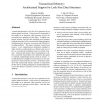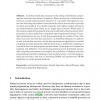14 search results - page 1 / 3 » Basic Program Structures for Avoiding Priority Inversions |
ISORC
2003
IEEE
13 years 9 months ago
2003
IEEE
: Structuring real-time concurrent programs in the form of groups of fixed-priority processes is an old art which is appropriate for only a small fraction of modern real-time distr...
ISCA
1993
IEEE
13 years 8 months ago
1993
IEEE
A shared data structure is lock-free if its operations do not require mutual exclusion. If one process is interrupted in the middle of an operation, other processes will not be pr...
HIPC
2004
Springer
13 years 9 months ago
2004
Springer
Abstract. Lock-free shared data structures in the setting of distributed computing have received a fair amount of attention. Major motivations of lock-free data structures include ...
IPPS
2006
IEEE
13 years 10 months ago
2006
IEEE
Achieving high performance for concurrent applications on modern multiprocessors remains challenging. Many programmers avoid locking to improve performance, while others replace l...
JPDC
2007
13 years 4 months ago
2007
Achieving high performance for concurrent applications on modern multiprocessors remains challenging. Many programmers avoid locking to improve performance, while others replace l...


